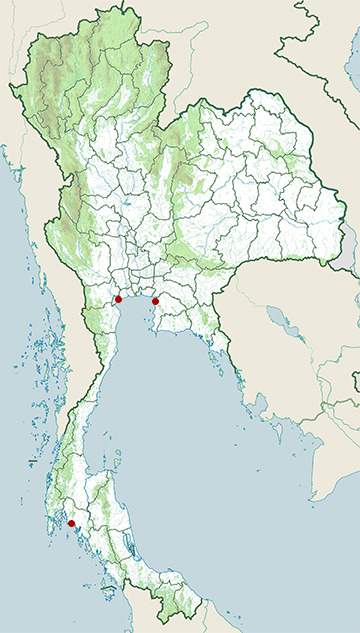Species of Thailand
Long-tailed jaeger
Stercorarius longicaudus
Louis Jean Pierre Vieillot, 1819
In Thai: นกสกัวหางยาว
The long-tailed skua, known as the long-tailed jaeger (Stercorarius longicaudus) in the Americas, is a seabird in the skua family Stercorariidae.
Etymology
The word "jaeger" is derived from the German word Jäger, meaning "hunter". The English word "skua" comes from the Faroese name skúgvur for the great skua, with the island of Skúvoy known for its colony of that bird. The general Faroese term for skuas is kjógvi . The genus name Stercorarius is Latin and means "of dung"; the food disgorged by other birds when pursued by skuas was once thought to be excrement. The specific longicaudus is from Latin longus, "long", and cauda, "tail".
Description
This species is unmistakable as an adult, with grey back, dark primary wing feathers without a white "flash", black cap and very long tail. Adults often hover over their breeding territories. Juveniles are much more problematic, and are difficult to separate from parasitic jaeger over the sea. They are slimmer, longer-winged and more tern-like than that species, but show the same wide range of plumage variation. However, they are usually colder toned than Arctic, with greyer shades, rather than brown.
This is the smallest of the skua family at 38 - 58 cm, depending on season and age. However up to 29 cm of its length can be made up by the tail which may include the 15 cm tail streamers of the summer adult. The wingspan of this species ranges from 102 to 117 cm and the body mass is 230 - 444 g.
Subspecies
Two subspecies are described:
- S. l. longicaudus – Vieillot, 1819: nominate, found in northern Scandinavia and Russia.
- S. l. pallescens – Løppenthin, 1932: found in eastern Siberia, Arctic North America, and Greenland.
Breeding
This species breeds in the high Arctic of Eurasia and North America, with major populations in Russia, Alaska and Canada and smaller populations around the rest of the Arctic. It is a migrant, wintering in the south Atlantic and Pacific. Passage juvenile birds sometimes hunt small prey in ploughed fields or golf-courses, and are typically quite fearless of humans.
They nest on dry tundra or higher fells laying two spotted olive-brown eggs. On the breeding grounds they can be heard making yelping and rattling sounds. Outside of the breeding season they spend most of their time over open ocean and have a harsh kreeah cry. This bird feeds on fish (mainly caught from other seabirds), smaller birds, food scraps, small mammals, fruit and carrion. On migration, long-tailed jaegers are more likely to catch their own food, and less likely to steal from gulls and terns than larger species.
This article uses material from Wikipedia released under the Creative Commons Attribution-Share-Alike Licence 3.0. Eventual photos shown in this page may or may not be from Wikipedia, please see the license details for photos in photo by-lines.
Category / Seasonal Status
BCST Category: Recorded in an apparently wild state within the last 50 years
BCST Seasonal status: Non-breeding visitor
Scientific classification
- Kingdom
- Animalia
- Phylum
- Chordata
- Class
- Aves
- Order
- Charadriiformes
- Family
- Stercorariidae
- Genus
- Stercorarius
- Species
- Stercorarius longicaudus
Common names
- English:
- Long-tailed jaeger
- Long-tailed skua
- French: Labbe à longue queue
- Thai: นกสกัวหางยาว
Subspecies
Stercorarius longicaudus longicaudus, Louis Jean Pierre Vieillot, 1819
Range: Northern Scandinavia and Russia.
Stercorarius longicaudus pallescens, Bernt Hartvig Ove Fabricius Løppenthin, 1932
Range: Eastern Siberia, Arctic North America, and Greenland.
Conservation status

Least Concern (IUCN3.1)
Photos
Please help us review the bird photos if wrong ones are used. We can be reached via our contact us page.
Range Map

- Chonburi Coast
- Krabi Coast
- Samut Songkhram Coast

